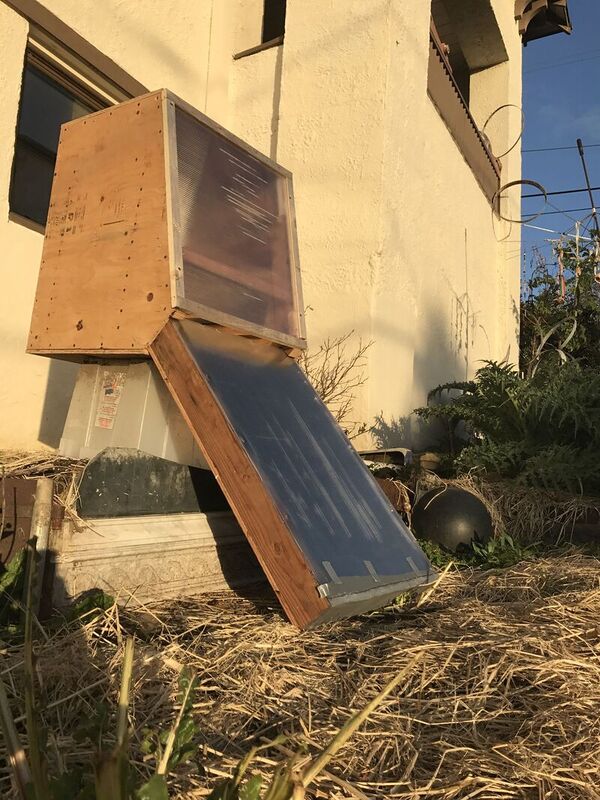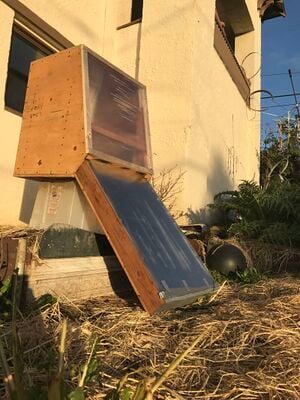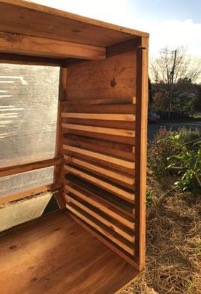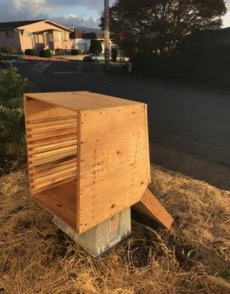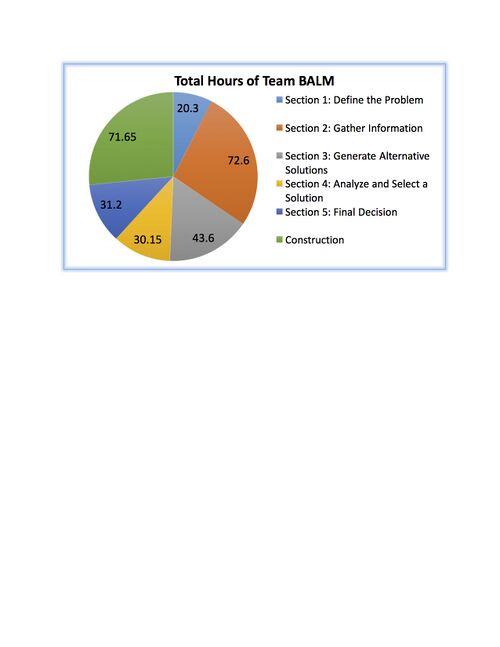Braydenleach (talk | contribs) |
No edit summary |
||
| Line 1: | Line 1: | ||
{{Template:ENGR215inprogress|5/9/2016}} | {{Template:ENGR215inprogress|5/9/2016}} | ||
{{copyedit|remember that all sections must have an overview, introduce all figures and tables, and only include references used on this page}} | |||
{{copyedit| no need for objective, objective should be stated in a formal tone in problem statement and criteria}} | |||
==Objective== | ==Objective== | ||
[[File:StagedPhoto.JPG|Left|600px]] | [[File:StagedPhoto.JPG|Left|600px]] | ||
*Our Objective was to provide The Sanctuary with a Low Cost, Low Maintenance, Energy Efficient way to preserve excess fruit and vegetables for later consumption. Our client, The Sanctuary, receives a lot of donated fruits and vegetables from the local food bank and local farmers who over planted in case crops were damaged. They sometimes struggle to make sure these food items don't go to waste so a great way to extend their consumption time window is to dehydrate them. That way they can even be consumed in the | *Our Objective was to provide The Sanctuary with a Low Cost, Low Maintenance, Energy Efficient way to preserve excess fruit and vegetables for later consumption. Our client, The Sanctuary, receives a lot of donated fruits and vegetables from the local food bank and local farmers who over planted in case crops were damaged. They sometimes struggle to make sure these food items don't go to waste so a great way to extend their consumption time window is to dehydrate them. That way they can even be consumed in the offseason of dehydration. | ||
==Abstract== | ==Abstract== | ||
{{copyedit| give more detail of the overall project i.g. convey to the readers what lies ahead on the page, refer to http://www2.humboldt.edu/engineering/sites/engineering/files/documents/writing_abstracts.pdf}} | |||
''The Solar Food Dehydrator that we have built will utilize the power of the sun to remove the water out of various fruits and vegetables. Air will enter through the bottom of the solar catchment where it will be heated and flow into the food drying compartment at the top of the unit. Water vapor will then exit through the vent holes cut into the back door of the food drying box.'' | ''The Solar Food Dehydrator that we have built will utilize the power of the sun to remove the water out of various fruits and vegetables. Air will enter through the bottom of the solar catchment where it will be heated and flow into the food drying compartment at the top of the unit. Water vapor will then exit through the vent holes cut into the back door of the food drying box.'' | ||
==Background== | |||
{{copyedit| make sure to use background pertinent to the project in a formal tone. e.g. who you are, the client, and the project in a jointed paragraph}} | |||
== Problem statement and criteria == | == Problem statement and criteria == | ||
{{copyedit|Please give more detail on the objective, desired outcome, and criteria. Reference all tables and figures. Also, consider if your objective statement really summarizes your entire objective. Make sure to introduce all tables. In constraints, use complete sentences to convey the point of the criteria.}} | |||
{| class="wikitable sortable" | {| class="wikitable sortable" | ||
|- | |- | ||
| Line 64: | Line 70: | ||
== Description of final project == | == Description of final project == | ||
{{copyedit| describe the final project with words referencing figures}} | |||
[[File:StagedPhoto.JPG|Left|300px]] | [[File:StagedPhoto.JPG|Left|300px]] | ||
[[File:Trays.jpg|Left|300px]] | [[File:Trays.jpg|Left|300px]] | ||
| Line 169: | Line 176: | ||
*''These will be added once more extensive pictures are taken or found'' | *''These will be added once more extensive pictures are taken or found'' | ||
== Maintenance == | |||
Introduce this maintenance section. | |||
=== Schedule === | |||
This is when to maintain what. | |||
<!-- Please keep the format the same as it populates the kiosk in CCAT. --> | |||
;Daily | |||
*A daily task | |||
*A daily task | |||
;Weekly | |||
*a weekly task | |||
*a weekly task | |||
;Monthly | |||
*a monthly task | |||
*a monthly task | |||
;Yearly | |||
*a yearly task | |||
*a yearly task | |||
;Every __ years | |||
*task | |||
*task | |||
=== Instructions === | |||
This is how to maintain. The step by step how to template {{Tl|How to}} is most likely best for this part. | |||
{{How to | |||
|title=How to Do Something | |||
|File:Bpack bike trailer - demo 1.jpg |Backpack frame bike trailer |1 |Do something. | |||
|File:Aleiha dish.jpg |Aleiha's parabolic solar cooker |2 |Do something really complicated but made simple, etc. | |||
}} | |||
== Troubleshooting == | |||
This is only how to troubleshoot basic operation. For complex issues, the solution might just say contact ________. It should be a table in this format: | |||
{| class="wikitable" | |||
|- | |||
! Problem | |||
! Suggestion | |||
|- | |||
| Example issue | |||
| Example solution or suggestion | |||
|- | |||
| Does not turn on | |||
| Make sure it is plugged in | |||
|- | |||
| Another issue | |||
| Et cetera | |||
|} | |||
==Discussion and next steps== | ==Discussion and next steps== | ||
After 274 hours of building this dehydrator, Team BALM has some recommendations in building this dehydrator that will be of use in replication. Using plywood that is straight and no warped in shape makes lining up components such as the door and the solar heat collector a lot easier. We also would have built our collection box in a size that we could have simply purchased trays for because tray construction is a hassle. Lastly, we would have made a full diagram before starting construction so if a size change or anything of that nature occurs, you can easily keep your dimensions and recalculate sizes rather than winging it. | After 274 hours of building this dehydrator, Team BALM has some recommendations in building this dehydrator that will be of use in replication. Using plywood that is straight and no warped in shape makes lining up components such as the door and the solar heat collector a lot easier. We also would have built our collection box in a size that we could have simply purchased trays for because tray construction is a hassle. Lastly, we would have made a full diagram before starting construction so if a size change or anything of that nature occurs, you can easily keep your dimensions and recalculate sizes rather than winging it. | ||
{{copyedit| fix grammar, use formal tone and complete sentences}} | |||
==References== | ==References== | ||
See [[Help:Footnotes]] for more. | See [[Help:Footnotes]] for more. | ||
Revision as of 05:21, 1 December 2016
Objective
- Our Objective was to provide The Sanctuary with a Low Cost, Low Maintenance, Energy Efficient way to preserve excess fruit and vegetables for later consumption. Our client, The Sanctuary, receives a lot of donated fruits and vegetables from the local food bank and local farmers who over planted in case crops were damaged. They sometimes struggle to make sure these food items don't go to waste so a great way to extend their consumption time window is to dehydrate them. That way they can even be consumed in the offseason of dehydration.
Abstract
The Solar Food Dehydrator that we have built will utilize the power of the sun to remove the water out of various fruits and vegetables. Air will enter through the bottom of the solar catchment where it will be heated and flow into the food drying compartment at the top of the unit. Water vapor will then exit through the vent holes cut into the back door of the food drying box.
Background
Problem statement and criteria
| Criteria | Weight | Description |
|---|---|---|
| Safety | 10 | Needs to be able to be operated without causing harm to users. Should have weight distributed in such a way that it is hard to fall over. Food must be safe to eat after dehydrated |
| Durability | 10 | Weatherproofing, insect proofing. Should not fall apart when not in use. Will be outside year around. (Door hinging for condensing the unit while not in use), Must last a couple seasons |
| Recycled Materials | 9 | In order to save on costs and uphold standards of Client, using recycled parts is a must. Must be constructed from appropriate materials |
| Insect Proofing | 9 | Food needs to be able to be dehydrated without the risk of bugs contaminating the food since the dehydrator must be outside in order to function |
| Effectiveness | 9 | The unit must function as designed and dehydrate food in a reasonable amount of time |
| Adaptability | 8 | Must be able to change whether it packing it up and taking it to a new location or storing it easily in the off season when dehydration cannot occur. |
| Portability | 8 | Design must be able to be moved about the Sanctuary's available space |
| Ease of Use | 7 | Must be able to be operated by an adult of average intelligence |
| Aesthetics | 7 | Must be built nicely and fit the lifestyle model of the client |
| Cost | 7 | Must be made as cheap as possible |
| Replicability | 6 | People must be able to look at our design and be able to make it for themselves if desired. |
Description of final project
How to Use
- Step 1:Cut desired fruits and vegetables into half inch pieces
- Step 2: Get the unit set up so that you are maximizing the sunlight that hits the collector
- Step 3: Open rear door and pull out a tray
- Step 4: Place fruit and vegetables on the tray
- Step 5: Close Door and check every 3 hours until items are dehydrated
- make this into a how to chart with pictures and such
How to Maintain
- 1. Clean trays after each use
- 2. Check Seals every 3 months
- 3. Check on the woods integrity after each season
- 4. Check if the plastic is maintaining after each season
- Add pictures and divide this up by frequency and potential cost
Costs
| Quantity | Material | Source | Cost ($) | Total ($) |
|---|---|---|---|---|
| 2 | 4'x8' -Pine Plywood | The Hardware Store | 22.00 | 44.00 |
| 1 | Corrugated Polycarbonate Plastic - 4' x 4', Transparent | The Hardware Store | 54.00 | 54.00 |
| 146 | Screws (Various Sizes) | The Hardware Store | 16.00 | 16.00 |
| 1 | Black Spray Paint | The Paint Store | 8.50 | 8.50 |
| 1 | Silicone Tube | The Hardware Store | 8.00 | 8.00 |
| 1 | Roll of Mesh Screen | The Hardware Store | 21.00 | 21.00 |
| 1 | Roll of Weatherproof .25”x17’ | The Hardware Store | 5.00 | 5.00 |
| Total Cost | $246.60 | |||
Labor
Testing Results
Will be added once testing is done. Maybe in a chart form showing the finished product
How to build
Template:How to Build the Food Drying Box
Template:How to Build the Heat Catchment
- These will be added once more extensive pictures are taken or found
Maintenance
Introduce this maintenance section.
Schedule
This is when to maintain what.
- Daily
- A daily task
- A daily task
- Weekly
- a weekly task
- a weekly task
- Monthly
- a monthly task
- a monthly task
- Yearly
- a yearly task
- a yearly task
- Every __ years
- task
- task
Instructions
This is how to maintain. The step by step how to template {{How to}} is most likely best for this part.
Troubleshooting
This is only how to troubleshoot basic operation. For complex issues, the solution might just say contact ________. It should be a table in this format:
| Problem | Suggestion |
|---|---|
| Example issue | Example solution or suggestion |
| Does not turn on | Make sure it is plugged in |
| Another issue | Et cetera |
Discussion and next steps
After 274 hours of building this dehydrator, Team BALM has some recommendations in building this dehydrator that will be of use in replication. Using plywood that is straight and no warped in shape makes lining up components such as the door and the solar heat collector a lot easier. We also would have built our collection box in a size that we could have simply purchased trays for because tray construction is a hassle. Lastly, we would have made a full diagram before starting construction so if a size change or anything of that nature occurs, you can easily keep your dimensions and recalculate sizes rather than winging it.
References
See Help:Footnotes for more. Template:Reflist
